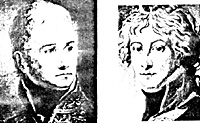
We are going to take a look at the Battle of Saalfeld based on the book:
Des Principes de la Guerre, (i.e. The Principles of War) [1] authored by Marshal Foch, the famous Supreme
commander of the Allied Forces in WWI.
MARSHAL LANNES (1769-1809) IN SPITE OF HIS YOUNG AGE (HE IS ONLY 36) IS ALREADY A VETERAN AND AN EXTREMELY CAPABLE COMMANDER FORMED IN THE WARS OF THE REVOLUTION AND THE CAMPAIGN OF 1805. HE CAN BE
CLASSIFIED AMONG THE TOP MARSHALS WITH DAVOUT AND MASSINA.
AT SAALFELD HE COMMANDS THE Vth CORPS AND WITH ONLY PART OF HIS CORPS, i,e. SUCHET'S DIVISION AND
TRRLLIARD'S CAVALRY BRIGADE, HE IS GOING TO DEFEAT THE MORE NUMEROUS
PRUSSIANS-SAXONS UNDER PRINCE LOUIS FERDINAND VON PRUSSEN (1772-1806).
PRINCE LOUIS FERDINAND VON PRUSSEN DOES NOT HAVE THE MILITARY EXPERIENCE OF LANNES. HE IS, ALONG WITH QUEEN LOUISE
OF PRUSSIA, AMONG THE GREATEST ADVOCATES OF THE WAR PARTY WITH FRANCE. HE
WAS AN EXTREMELY BRAVE MAN AND WAS KILLED AT THE END OF THE BATTLE.
This book is a summary of lectures delivered to the French Staff College by Marshal, then Lieutenant-Colonel, Foch
back in 1903. Foch, like Bressonet and Colin, was part of the French Staff
College and reflects the French military thoughts of the period.
Unlike Bressonet's Etudes Tactiques, Marshal Foch is not concerned with
minor tactics, but with grand tactics and grand tactical to strategic
principles, Hence formations are seldom mentioned in Foch's work. Yet, Marshal
Foch's book is a very complete work on the art of war as seen in 1903. I would
strongly recommend it to anyone, wargamer or professional soldier, to read it.
For our part, we have learned a great deal on conducting a battle by reading
the chapter covering Saalfield, we hope you will as well.
For our part, we'll be working exclusively with the chapter pertinent
with the Battle of Saalfeld as it brings up all the principles involved in
deploying and preparing an attack. These principles should be of the utmost
interest to any wargamer trying to apply real tactics to wargames, What is
most unusual in Foch's account of Saalfeld is that the timing as well as the
details of the deployment are given in a very clear manner.
All the tactical and grand tactical comments presented in the
following article are from Marshal Foch's work. Our comments and
conclusions are clearly identified.
In addition, Marshal Foch provides us with a multitude of principles
concerning the role of the vanguard during a lengthy deployment.
Unfortunately, that part of his work is too lengthy and will have to wait to
be examined in a future article.
On October 9, 1806, the Grand Army, in three columns, is completing its
crossing of the Frankenwald in order to enter Saxony. The advance guard of
the army (First Corps and three cavalry Divisions under Murat) precedes the
central column. It has beaten, at Saalburg and Schleiz, the Tauenzien Division.
In the right hand column, the head corps (IVth Corps) has reached
Plausen and the VIth, which is following, is at Hof.
In the left hand column. the Vth Corps (Lannes) which forms the vanguard
is coming from Coburg. On October 9, after a long and difficult march, it has
reached Griffenthal with the Suchet Division and its cavalry: its Znd
Division is four miles to the rear; the VIIth Corps (Augereaul has reached
Cobourg (see Map 1).
Napoleon knows the main enemy army to be under Brunswick is between
Gotha and Erfurt. advance guard at Eisenach and Hohenlobes army to be at
Jena, advance guard at Saalfeld. The Emperor believes the intention of the
enemy is to march on Wurtzburg. the first army via Gotha and Meningen, the
other via Saalfeld and Coburg, He has to foresee the possibility of his
enemy's forestalling his central column, and attacking with superior forces
the left column of the Grand Army. Hence the line of conduct he fixes for
Marshal Lannes. [2]
He orders him:
(2) In the contrary case, that is, if the enemy, after to hold on so as to
give the Emperor the time to arrive with 20,000 to 25,000 men.
(3) In case the enemy's rapid advance should not allow help the time to
intervene, to withdraw to Griffenthal. On October 10, Lannes Corps progresses toward Saalfeld at the speed
of 4 kilometers (2 1/2 miles) an hour on a single column. The column
consists of:
(2) Main Body: 34th of the Line (3 battalions), 40th, 64th, 88th of the
Line (2 battalions each) and the Divisional artillery (2 12-pdr, 6 8-pdr and
2 howitzers.) There is no interval between the advance guard and the main body. At
the head of the troops rode Marshal Lannes, His Chief of Staff is General
Victor, the eldest senior officer of the column, forty years old. The cavalry
had been sent forward and pushed back some enemy patrols. A few enemy
squadrons were seen above Saalfeld.
The cavalry brigade made up at a trot for the issue of the woods
followed by the "elite" battalion which hurried forward. The Marshal arrived
at the issue of the woods. A few enemy outposts had been established near
the road and on the hills commanding Saalfeld. They were reconnoitered then
attacked with infantry (first action at about 9 am). They were driven back.
The advance guard arrived in front of Saalfeld. It was nearly 10am.
MAP 2: SHOWING THE INITIAL SITUATION AT SAALFELD AT 10AM AND THE DEPLOYMENT
OF THE PRUSSIAN ARMY AROUND 10-IIAN AS WELL AS THAT OF THE FRENCH INFANTRY
AT THE SAME TIME.
At a distance of about two miles is the Saale valley, On the river,
Saalfeld, a big town with a circumference of about 2 miles, 300 feet below
the level of the woods. Garnsdorf is half way down the slope. More to the
north is the small valley of the Siegenbach, then another, that of the
Beulwitz brook and the towns of Beulwitz, Cresten and Wolsdorf. Further to
the north, the ground rises and forms a spur which commands the bend of the Schwarza and its
confluence with the Saale. Highest point of this rise is the Sandberg, The
whole countryside is absolutely without cover.
The Marshall's observation is completed by studying the openly displayed
enemy army. At the foot of the slopes, on three regularly and correctly drawn
lines, appears a force that Marshal occupied by the enemy. A few enemy
squadrons are seen maneuvering up-river above the town in the direction of
the gap of the Saale.
The Prussian Division has its back to the Saale. In case of defeat, it
can only retire over the bridge of Saalfeld or over that of Schwarza. It is
easy to measure its force. It can not be reinforced for a long time. Lannes
will therefore attack, according to the spirit of the orders he has received.
MAP OF THE SAALFELD BATTLEFIELD FROM BESSONET'S ETUDES TACTIQUES, SHOWING
THE SAALFELD BATTLEFIELD AS IT WAS IN 1806. SAALFELD AND OTHER VICINITIES
WERE MUCH SMALLER THAN TODAY AND THE GROUND MUCH MORE OPEN, IN ADDITION THE
MAP SHOWS TOPOGRAPHIC DETAILS (THE ABOVE MAP IS SHOWING MORE TRAILS) OMITTED
FROM THE MAPS 2, 3 AND 4.
It's outposts are spread out from Oberhof to
Kahlerten and had reserves at Appurg (5 squadrons) and at the Blankenberg (3
battalions, 1/2 battery and 3 squadrons).
On the 9th, Prince Louis, after hearing that Lannes' Corps had arrived at
Graffenthal, concentrates his Division at Rudolstadt and orders Saalfeld to be
occupied by the reserve at Blankenberg, less 1 battalion, and reinforced by a
heavy battery (12 guns in all). There are, therefore, at Saalfeld, since the
night of the 9th: 2 Prussian battalions, 1/2 light battery, 1 heavy 1 company of light infantry and 3 squadrons of hussars.
On the same day, the 9th, Prince Louis received from Prince Hohenlohe the order to come to Possnech via Saalfeld, as Boon as the posts of Blankenburg and Rudolstadt have been relieved by detachment's from Blucher. However, Prince Louis has a different idea of his own. He decides to give battle in order to save Saalfeld where there was a depot of stores.
Early in the morning of the 10th, having heard of the march of the French Corps on Saalfeld, he sets his Division moving toward Saalfeld via Schwarza. He arrives at about 9 as at a point in line with Wolsdorf, while the small advance guard action mentioned above is taking place. He forms his Division in three lines, on a low ridge placed to the left rear of Crosteft and in front and to the right of Graba.
What does Prince Louis intend to do? According to the 1806 Prussian doctrine, he has left to the French
the uncomfortable and difficult slopes which rise towards the Woods and has kept to the bottom of the valley where regular maneuvers are easier. It is, in 1806, in the Prussian army a matter of principle that it is necessary to attack so to recreate the glorious 1757 victory at Rossbach all over again, That attack must take place when the enemy debouches from difficult ground. To attack in echelon is the last word of science. [3]
In order to achieve that maneuver, what you need before all else is an
open ground for maneuver. The 1806 Prussians did not know how to fight in any
other fashion. [4]
In addition, as a result of the 18th century views prevailing within the
Prussian army, Prince Louis does not doubt that the French will take Saalfeld
as an objective. Saalfeld is a storehouse, a road junction, a crossing over
the Saale. (i.e, a complete geographical objective)
Unfortunately for Prince Louis, the French generals trained during
the Wars of the French Revolution ignore the whole science of
geographical points .....
In spite of the very clear Prussian dispositions, Lannes has
nevertheless sent patrols to prevent any surprises. Light cavalry parties
had also occupied Beulwitz as well as the eastern corner of the forest, on
the right above the gap of the Saale. They scouted from that point in all
directions in order to confirm all the reports concerning the enemy.
How is Lannes going to develop his attack against an enemy so neatly
drawn on the foot of the hills?
He decides to attack from the left. In that direction, the attack may
be prepared without the enemy being aware of it. The attack will be launched
between Aue, the Sandberg and Wolsdorf, where the ground is easy to advance
over, though hilly. It is now 10 am. The French column is arriving but the
march grows slower because of the congestion of the road. Three to four hours
pass before all the units can be deployed and assembled on the reconnoitered
ground.
But, one must realize that during such a long lapse of time, the enemy
may attack the debouching columns. He must be prevented from doing so. That
is the task of the advance-guard.
To "stand on guard" is to get hold of everything that may help in
checking the enemy's advance. Such is the first act in the preparation for
the battle. [5]
So, Lannes ordered the following dispositions: (see Map 2)
(2) The remainder of the Division will march through the wood or along
the outskirts of the wood, making for Beulwitz (the remainder of the Division
consists of four regiments and artillery),
(3) The 'points d'appui' of Garnsdorf and Beulwitz must be connected by
skirmishers. Cavalry are to establish themselves behind those
skirmishers. Later, after the troops shall have arrived in sufficient numbers, this
front - which is still weak - will be consolidated by a reserve; it will be
formed of the last two battalions arriving on the ground.
As seen from the above, Lannes' dispositions tends from the outset
towards Beulwitz. At about 11, the French had established two companies at
the southern corner of the wood, one battalion and two guns at Garnsdorf and
two battalions at Beulwitz. [6]
From the corner of the wood to Beulwitz the distance is 3500 yards,
Lannes is not afraid, as seen above, to spread his advance guard over so
considerable a front. That is the 3 1/2 battalions and his cavalry brigade. It
must be realized that, so far, troops are only taking possession of the
ground, more or less being simple watchmen.
The artillery section (under Simonet), making use of a favorable
position, opens fire against a much superior battery (12 guns, 1 heavy
battery and 1/2 light one) and against the troops at Saalfeld, that is two
battalions which are holding in the open the approach to that town. The
artillery section is supported in its action by a line of skirmishers
established on the ridge and by the occupation of Garnsdorf.
At Beulwitz, the 17th Leger has occupied the village and sent out
skirmishers who, using gardens and orchards, have arrived near Crosten. Some
scouting is also carried out to the north
of this regiment by cavalry patrols. At Beulwitz as at Garnsdorf, the
skirmishers have crept up on the formed, unsheltered enemy to deliver a very
deadly target-fire.
Unopposed by the enemy, Lannes' troops continue to deploy and by 1
pm., the greater part of the French are found to have arrived as ordered.
As for the Prussians, what impression did they derive from
all these actions?
All the information concerning them is borrowed from the work of an
eye-witness, the Saxon engineer Mumpfling, author of the Vertraute
Briefe.
After describing with little praise the situation in which the Prussian
army was drawn up, he adds:
The maneuvers of the French were developing more and more, their object
was to fend off the troops posted on the left wing above and near Saalfeld
and to keep the whole front of the Prince's position busy with their
skirmishers, always edging for the left, so as to envelop the Prince and out
him off from the Schwarza. The above, of course was written after the event and shows that the
writer had understood what the French preparation aimed at. However, during
the action itself, the intentions of the French were not so easy to discover.
Save the fire of the skirmishers, nothing could be seen on the horizon,
Reconnoitering parties sent out very early in the day saw columns marching on
Biba, on the main road, and on Beulwitz. These columns, however, had all
disappeared and, so far, nothing but an insignificant skirmish attack had
taken place. What then are the intention of these colusns of which nothing is
seen? One battalion (2nd Mufling) is sent to Schwarza.
At the same time an order arrives from Prince Hohenlohe to remain at
Rudolstadt and not to attack, as the army is coming from Blankenhayen to
the Saale.
A battery and and the 1st Mufling battalion is ordered to the
Sandberg. Then, other battalions establish a link with the main Prussian
body, The attack is ready....
A retreat by Schwarza, in case of a check, becomes more and more
important. Hence, the Prince orders the foot battery and the 1st Mufling
battalion to occupy the Sandberg.
Then, the Prince-Clement regiment is ordered to establish one battalion
(the 1st) between Aue and Crosten, in order to connect this occupation of the
Sandberg with the main body of the Division. The 2nd Clement battalion is to
climb up on the Sandberg where it is to place itself on the right of the
battery and of the 1st Mufling.
So far, the Prince's dispositions have committed two regiments and 12
guns to occupy and defend Schwarza and hills commanding that place. In
addition, two battalions and 12 guns are occupying Saalfeld.
It is about 1 p.m.. After making all those concessions to the value of
positions, Prince Louis, a very bold and enterprising men of action,
decides to attack. He attacks straight in front of him with all the forces
available: six battalions out of twelve (without artillery, without any
kind of preparation). Four battalions are in the first line and two in the second.
As soon as that attack takes place going up east of the line Crosten- Beulwitz, its right is immediately fired upon by the numerous swarms of French skirmishers filling the gardens, orchards and hollow roads near the villages, still invisible and pouring a hail of bullets on the right of the attack. The Prussian line wavers, stops, answers by volley fire -- without much result -- when, at the same moment, it is attacked in flank by two battalions of the
34th, which after marching under the cover of the slopes, appear and charge in
column with drums beating, General Suchet at their head.
The ordeal is too severe, The Xavier regiment falls back, the left of
the line withdraws in the same way (regiment of the Elector), The 17th Leger
follows on their heals into Crosten, but is taken in flank by the reformed
Prussians, mainly by the regiment of the Elector, which had not suffered too
badly. The 17th, having no cartridges left, loses Crosten and retires on
Beulwitz, where it is relieved by the 64th, and goes over to the reserve.
It is about 2 p.m- Marshal Lannes find's that the situation is maturing:
He decides to attack in the direction previously decided upon, i.e.
between Beulwitt and Crosten. He will strike the enemy mass in the plain with
the main forces of the Division. That is the Claparede brigade (17th and 64th)
attacking in front and the Reille brigade (34th and 40th) attacking in flank.
But he must, before that attack, protect himself against the troops
holding the Sandberg and Aue and give the two attacking brigades the space
required for deployment.
The Reille brigade is entrusted with that two fold task,
Consequently, it marches in the direction of the Sandberg toward Aue wood under the protection of skirmishers. The 34th being in the first line. In echelon to the left rear comes the 40th and in echelon to the right rear, the 21st L6ger.
[8]
The brigade first strikes the Clement regiment. then the battery of the Sandberg, 15 guns,
which it captures. The 40th is almost entirely spent in this struggle against the battery and it's support, so it shall secure the vital points: Aue and the Sanberg. As ordered, a pursuit is carried out with part of his forces and with what is remains available, the wing attack upon the enemy right flank, The 34th will carry out the attack.
It is nearly 3 pm. The moment has come to conclude the whole affair and to carry out the
final attack that has been planned since the morning.
The artillery has arrived in the meantime. It is ordered to take position near Beulwitz. Then it advances and by firing a few rounds of canister, prepares the infantry attack.
Lannes orders the charge to be beaten and sounded on the whole line. Then, on that
enemy already shaken by fire, arrives "masses of infantry which, coming down at full speed from
the heights, falls on the Prussians battalions like wild torrents and rout them in one instant"
(Marbot).
Engineer Mumpfling also describes this very well:
Such are the results from the Prussian side. But what had happened on the French side?
At the general signal of attack given by Lannes, all the troops near Beulwitz pushed forward. Thus was launched:
(2.) A flank attack, 34th Line (3 battalions). So, Marshall Foch remarks that we have the whole cavalry, the whole artillery (less 2 guns) and 4 infantry regiments (out of 5) attacking, all at once, an enemy already shaken by fire. The attack was carried from a short distance (i.e. by surprise) and a superiority of means on the very point of the enemy line which had been selected as the easiest to approach and specially prepared as a point of attack, The front of the attack was 1500 to 1800 yards wide for all the acting troops. This is less than the 300 yards of front to a battalion prescribed by the regulations.
It is mainly the French left which strikes the more advanced Prussian wing. To the right, we find cavalry supported by infantry (88th), They came down in one mass to the plain.
That cavalry soon found a favorable opportunity for charging the Prussian infantry, which was being hard pressed on all sides by the French infantry and fired on by artillery. The cavalry charged and sabered through the mass of men for half an hour. Prince Louis of Prussia, seeing his infantry beaten, hurried up to his squadrons near Wolsdorf, but all the cavalry force he could muster consisted of only five weak squadrons. Nevertheless he came on, but in vain, at their head attacking the 9th and 10th hussars, who were advancing to complete the work of the infantry. The superior strength of the hussars enabled them to overlap both flanks of the enemy, who had been, moreover disorganized by the uneven ground.
The Prussian defeat was complete, There remained nothing but fugitives flying as best as
they could towards Blankenberg, Schwarta or across the Saale.
At the moment the general attack started, General Victor had assembled at Garnsdorf his
"elite" battalion, both companies of the 17th (that had been previously placed in the wood) and
marched on Saalfield which he carried. Then he continued the pursuit of the enemy as far as
Rudolstadt by the right bank of the Saale.
Pursuit was also continued in the direction of the Schwarza. Claparede there led a whole
brigade (17th and 34th), which drove the enemy back beyond Blankenberg and
crossed the Schwarza.
According to Foch, fifteen hundred prisoners, four flags, twenty five
guns, two howitzers, six wagons, such were the trophies of the day, But we
should point out that no one has related with precision the losses in dead of
the Prussians. Hoepfner claims that the Prussian and Saxon losses were under
2000 killed, wounded and prisoners, That appears to be too light of a loss.
Housaye gives a figure of 3000 killed, wounded and prisoners which is
apparently closer to the truth
The French losses, according to Lannes were light: 172 casualties. The
Simonet artillery section of 2 4-pdr had fired 264 rounds, The divisional
artillery had not used quite so such ammunition - about 236 rounds, The
infantry had fired about 200,000 cartridges which makes the rather
considerable average of 20 per man.
We find confirmation of many points argued in our previous article on
Bressonet's conclusions.
The main point here concerns the effectiveness of unopposed skirmishers. At Saalfeld, their effectiveness is recognized by Foch as well as by a Saxon eyewitness to the ordeal. Like at Jena, we see formed troops standing for hours under the fire of unopposed skirmishers as reported
by Engineer Mumpfling:
Was that an isolated instance during the Campaign of 1806? Certainly
not. In EE&L 2, in our analysis of Bressonet's conclusions we also presented another similar
eyewitness account at the Battle of Jena, That of Lieutenant von Borcke of
Ruchel's Corps in which Von Borcke states:
We have there a very similar situation of troops exposed to unopposed
skirmishers but this time note the terrible effect that the combined fire of
the artillery and the unopposed skirmishers had on Richel's Corps, The very
same thing had taken place a little earlier in the front of Viergehnheiligen
where that deadly combination of unopposed skirmisher fire and artillery took
a heavy toll of Hohenlobe's troops that stood there, inactive, for two hours,
while Napoleon's reserves were building up for the final onslaught which
routed Hohenlohe's command as it later did fichel's Corps, The very same had
taken place at Saalfeld.
From the above, I can only reiterate the effectiveness of unopposed
skirmishers in somewhat shaking up an enemy line and repeat my statement
published in EE&L 2.
However, I do partially agree with Bressonet on the following:
Which does not mean that if the tirailleurs had been used by the
Prussians, their ability to resist would not have been better!
But let us not be carried away by tactics and forget the main and most
important principles outlined by Marshal Foch, because tactics alone do not
win battles.
Perhaps the most striking point to any wargamer is the considerable
amount of time needed at Saalfeld for Lannes to deploy his troops and prepares
his final attack. He patiently prepared the battle for 6 hours! But let us go
back to Foch.
The theory which has been put in practice by Lannes is obvious, One
clearly sees how the maneuver of long duration (from 9 am to 3 pm) aims
exclusively at bringing about the powerful, undisputable conclusion by
means of all the main forces. Such conclusion being preceded by a
preparation to which the smallest number possible were devoted.
The determination of the point where to execute the main and final
effort is very important. The direction selected for attack must include
good means of access, few obstacles and space to maneuver in force. Of the
main body in reserve for the final attack, two parts must exist:
(2) The security disposition for that attack, the weaker (88th), designed
to support and protect the decisive attack. In any case: this is the last
reserve of the front. In the process of execution (through maneuver and/or fire), the decisive
attack would tend to achieve such a combination -- envelopment or attack in
front and in flank -- as would enable numerical superiority to develop all the
effects of which it is capable. The attack in front and the attack in flank
remaining in any case closely connected with each other.
The decisive attack should be carefully prepared by artillery. Finally,
at the moment when the enemy is worn down and held on his front, threatened
on his most exposed flank, and about to be assaulted by the decisive main
attack; we add the final ingredient. A general attack across the entire
battle line is let loose, today as in the past, in order to prevent the enemy
from parrying the final effort.
Then comes the pursuit, without truce or mercy, with troops as well
in hand as possible, commanded at Saalfeld by Victor and Claperede.
That theory of the decisive attack had been perfectly grasped by the
Prussians of 1813, from studying the wars of the Empire.
Proof:
"As it has come to my notice that, during actions and battles, the various
arms have not been always conveniently brought into action and that
dispositions in view of battle are generally unsatisfactory, I desire upon the
occasion of the coming resumption of hostilities, to recall the following
rules of war:
These are the general principles:
(1) In view of the manner in which our enemy is mating war, it is generally
unwise to begin a battle with cavalry, or to bring all the troops immediately
into action, owing to the way in which he uses his infantry, he succeeds in
delaying and supporting the action; he carries villages and woods, bides behind
houses, bushes and ditches; he knows how to defend himself skillfully against
our attacks by attacking himself; he inflicts on us losses with a few troops,
when we advance against him in great masses; he then relieves those troops, or
send fresh ones into action and, if we have no fresh troops to oppose his, he
compels us to give way. We must draw therefrom this principle, which is the
enemy's, that we must spare our forces and support the action until we turn to
the main attack.
(2) Our artillery has not produced a great effect, because it has been too
much divided
(6) War in general, but above all, the issue of battle, depends upon
superiority of forces on one point.
(7) In order to secure this superiority of forces, it is necessary to
deceive the enemy concerning the real front of attack and to make a false
attack and a real attack.
(8) Both attacks must be masked by skirmishers, so that the enemy should be
unable to distinguish the difference.
(9) A line of skirmishers is first of all to be sent out. The attention of
the enemy is to be drawn by several battalions designed to fire on one of the
wings, on which guns must be firing heavily at the game moment. Battle must be
ordered in that fashion.
(10) Meanwhile, the real attack is still postponed and it only begins later
on, at the moment when the enemy's attention is entirely turned on the false
attack.
(11) The real attack is made as quickly and as vigorously as possible and
above all by a large mass of artillery and infantry, of a superior force, if
possible, while a particular corps goes round the enemy flank. In principle, a
commander should devote one brigade [10] to
the false attack, two brigades to the real one and have one brigade in
reserve. "These are principles which are well known to you and which have been
several times recommended. We have put them frequently into practice in our
peace maneuvers but I remind you of them, because what is known is sometimes
forgotten, because though a simple thing may seem to be commonplace, yet
victory often depends upon it. Unless one is careful to recall it everyday to
mind, one indulges in combinations which are too scientific, or, what is
worse, one goes into battle without having taken any disposition
whatever." Then Foch goes on to his own conclusions:
'As we see, after explaining the theory of the preparatory attack, or false
attack, and of the decisive attack, which he calls the real attack, after
showing by what kind of actions this theory must express itself, the King
states, in order to make more precise for the use of undecided minds: 'Out of
four brigades, you shall devote one in the false attack, two to the real one
and one to the reserve.' Later on, a prefect will lay down the formula: a
third in order to open, a third in order to wear down and a third in order to
finish."
XI. Further Conclusions from J. Lochet
So here we are, the King has laid down the Napoleonic principles of war.
[11]
In addition, all the true principles of war have been presented for us,
We just have to apply the&, providing we have our own self discipline to obey
principles (see what the King says) and also realistic rules that allow us to
practice them, (And that is far from a sure bet!). All of this constitutes
the nuts and bolts of the Napoleonic battle.
So, what happened at Saalfeld?
Basically:
(1) Prince Louis didn't concentrate his command. Quite the contrary, he
dispersed it. So did Hohenlobe at Jena.
(2) In sharp contrast with the Prussian commander, the unfortunate Prince
Louis, all the above Napoleonic principles were applied by Marshall Lannes at
Saalfeld. That's what gave him victory.
(3) Tactics were secondary. It certainly was not the minor tactics or the
formations used columnar or linear - that were the decisive factor but the
careful planning of the final onslaught, Granted, the absence of skirmishers
did not help the Prussians. But formations and tactics - although a
significant help - were used to fit a tactical situation at a given moment
and were not an end by themselves.
Once more it is the application of the above principles that won the
victory. Take away these principles and one has nothing.
A much more complete comparison between French and Prussian tactics and
grand tactics in 1806 can be found in the fine article authored and presented
by Scott Bowden at Historicon '92: "French and Prussian at War: 1806 -- A
Discussion of the Battlefield Myths and Realities of the
Saalfeld-Jena-Auerstadt" to be found in EE&L 1.
The top photo shows open ground from Wolsdorf towards the Saale. In 1806, the Saalfeld
battlefield looked that open, but that is no longer so. The bottom photo shows the
ground from the Sandberg towards Saalfeld. That part of the battlefield is still much
the way it was in 1806 and gives a good idea how Lannes was able to deploy without being
seen by the Prussians. It is also ideal Skirmishier country.
The Battlefield Today
Most of the Saalfeld battlefield has considerably changed since 1806. It is
no longer possible to see the entire battlefield as Marshal Lannes did when he
emerged from the road to Coburg. Garnsdorf, the suburb of Saalfeld like that
city itself, has expended considerably and is now heavily wooded. All the
other battlefield features with the notable exception of that of the Sandberg
are no longer recognizable. Prince Louis area of initial deployment is covered
by army barracks.
The Sandberg, as shown on one of the photographs, gives an idea of the
ground around Saalfeld in 1806. The map reproduced below gives a good idea
on how Lannes was able to deploy his troops without being seen by the
Prussians. In addition, it was ideal skirmisher's country.
[1]> The translation The Principles of
War have been published in 1920 by Henry Holt and Co, New York.
This article appears in MagWeb (Magazine Web) on the Internet World Wide Web.I. The Grande Army and Lannes' Movements Prior to the Battle of Saalfeld
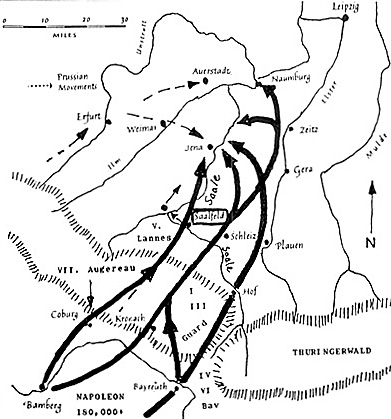 MAP I SHOWING THE FORWARD MOVEMENT OF NAPOLEON'S BATTALION CARRE TOWARD SAALFELD-JENA, LANNES WITH THE V CORPS IS THE VANGUARD OF THE LEFT COLUMN. AUGEREAU'S VII CORPS FOLLOWS.
MAP I SHOWING THE FORWARD MOVEMENT OF NAPOLEON'S BATTALION CARRE TOWARD SAALFELD-JENA, LANNES WITH THE V CORPS IS THE VANGUARD OF THE LEFT COLUMN. AUGEREAU'S VII CORPS FOLLOWS.
(1) To call up the VIIth Corps and to attack if the enemy has not more than
15,000 to 18,000 men.
(1) Advance Guard: A light cavalry brigade (Treillard): 9th and 10th
Hussars, 21st Chasseurs of 3 squadrons each, 1 section of artillery (2 4-pdr),
1 "elite" battalion (8 companies of the last 4 regiments of the Division), the
17th Leger (2 battalions and 2 "elite" companies) under Claparede
II. The Initial Situation at Saalfeld
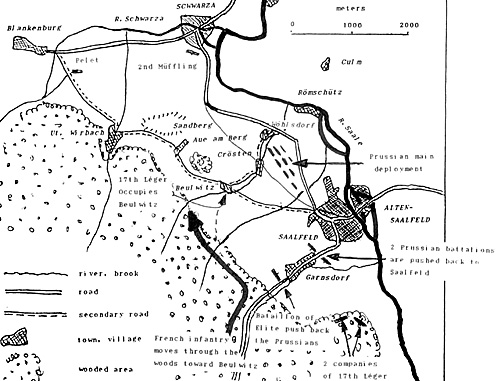 Marshal Lannes, at the head of his infantry, halts on the
hill commanding Garnsdorf. This is what he sees: (See MAP 2)
Marshal Lannes, at the head of his infantry, halts on the
hill commanding Garnsdorf. This is what he sees: (See MAP 2)
III. The Events and Intentions from the Prussian Side
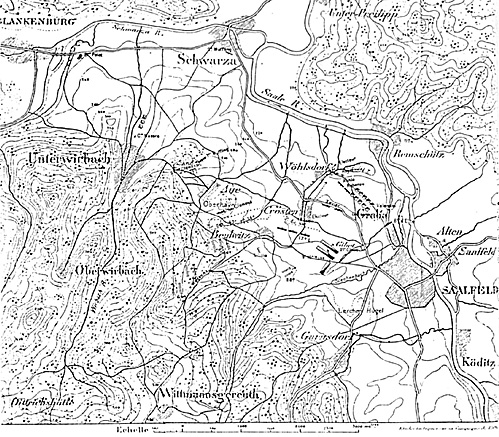 Since October 7, the Division of Prince Louis -- the advance guard of
Hohenlohe's army, including 18 squadrons, 12 battalions, 27 guns -- was
cantoned north of Rudolstadt.
Since October 7, the Division of Prince Louis -- the advance guard of
Hohenlohe's army, including 18 squadrons, 12 battalions, 27 guns -- was
cantoned north of Rudolstadt.
V. Lannes Initial Dispositions and Deployment
(1) The 'elite' battalion will continue to drive back on Saalfeld the
Prussian posts holding the hill and will stop at Garnsdorf, which it will
occupy in strength. Cavalry will place themselves in reserve at the bottom of
the Siegenbach valley. Then, the 17th Le6ger will send its two "elite"
companies to occupy the north-east corner of the wood facing the gap of the
Saale, which they will have to defend. That regiment will occupy, with the
reminder of its forces, Beulwitz, which it will reach by marching along the
woods. The artillery section will fight at Garnsdorf. General Claparide will
command at Beulwitz and General Victor will command at Garnsdorf and south of
it,
VI. Preliminary Actions on the Prussian Side
"Can you not see us all in line before that threatening rampart and
lying unsheltered on the narrow stretch of meadows which separates it from
the Saale, with our back to the river? From that rampart, enemy skirmishers,
[7] themselves under perfect cover, could
easily pick out any one of us, without it being possible to return fire on
completely invisible men; and this past time continued for several hours
(apparently two hours, i.e. from 11 am to 1 pm, JAL). During that
time, the French commanders, who, from their places, could thoroughly mark the
weak points in our line, took their disposition accordingly....
VII. The Prussian Attack
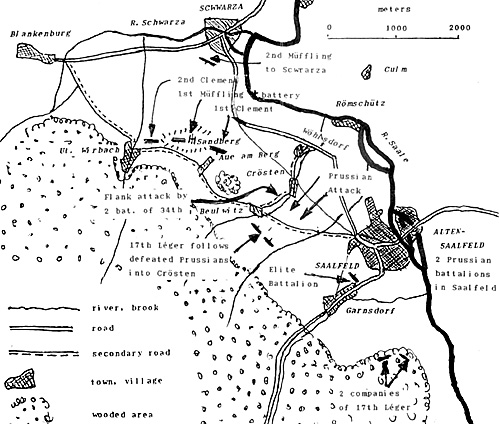 MAP 3 SHOWING THE PARTIAL REDEPLOYMBNT OF THE PRUSSIANS PRIOR TO THEIR ATTACK
AND THE LOCATION OF THE FRENCH, THE TIME IS ABOUT 1 PM.
MAP 3 SHOWING THE PARTIAL REDEPLOYMBNT OF THE PRUSSIANS PRIOR TO THEIR ATTACK
AND THE LOCATION OF THE FRENCH, THE TIME IS ABOUT 1 PM.
VIII. Lannes' Attack
(1) All his troops are present and deployed;
(2) the enemy has been well reconnoitered;
(3) he has been immobilized;
(4) his
forces are in a dispersed order and already shaken."At about 3." he writes, "the French columns fell upon us like an avalanche. In the twinkling of an eye, we found ourself out up into three bodies. surrounded by a circle of fire and forced back on the river."
(1) A frontal attack, including to the right, 9th and 10th hussars, in the center, 54th Line, to the left 21st Leger; having in the second line the 87th Line and 17th Leger.
IX. Combats Around Garnsdorf, Saalfeld, and the Pursuit
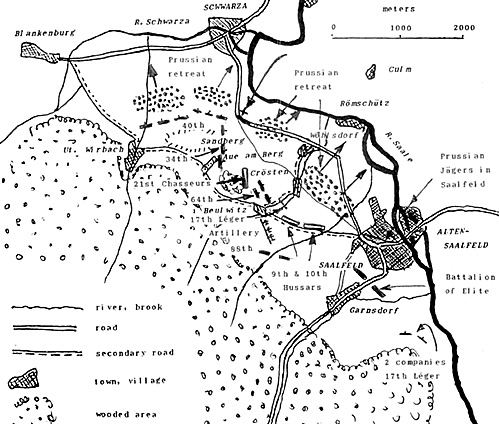 MAP 4: SHOWING THE FINAL ACTIONS AND THE PRUSSIAN LINE OF RETREAT, PRINCE
LOUIS WAS KILLED AT THE POINT SHOWN ON THE MAP.
MAP 4: SHOWING THE FINAL ACTIONS AND THE PRUSSIAN LINE OF RETREAT, PRINCE
LOUIS WAS KILLED AT THE POINT SHOWN ON THE MAP.
X. Conclusions
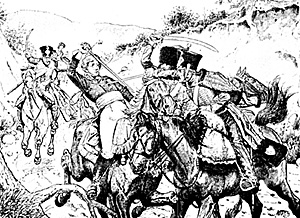 DEATH OF PRINCE LOUIS AT SAALFELD ON OCTOBER 10 1806 (COMPOSITION BY R. KNOTEL)
DEATH OF PRINCE LOUIS AT SAALFELD ON OCTOBER 10 1806 (COMPOSITION BY R. KNOTEL)
"From that rampart, enemy skirmishers could easily pick out any one of us.... and this
past time lasted for several hours."
However, from a great distance, the bullets of hostile skirmishers already
reached us; they were placed formidably in the front of us laying down in the
field, bushes and covers; we were unacquainted with such tactics; the bullets
appeared to come from the air. To be under such fire without seeing the enemy
made a bad impression on our soldiers. Then, because of the unfamiliarity with
this sort of fighting, they lost their confidence in their muskets and
immediately felt the superiority of the adversary. They therefore suffered,
already being in a critical position, very quickly in bravery, endurance and
calmness and could not wait for the time to fire themselves which soon proved to
be to our disadvantage."
But, it is also evident to report that if, on open ground, the fact of
not using tirailleurs in liaison with the line battalions has been more
costly to the Prussian battalions in their effort to advance, the lack of
tirailleurs did not prevent them from resisting us vigorously until the
action of new French troops on the weak points of their line or on their
flanks forced them to give in."
(1) A main one, devoted to the decisive attack (17th, 34th and 64th),
INSTRUCTIONS FOR OFFICERS COMMANDING CORPS, BRIGADES ETC, DELIVERED BY
KING FREDERICK WILLIAM DURING THE TRUCK OF 1813:
Footnotes
[2]> That line of conduct is clearly seen
in the letters between Napoleon and Marshal Lannes too numerous to quote here.
[3]> See Clausewitz On War, pp. 247-8
quoted in BEL 2.
[4]> Marshal Foch. The Principles of War,
p. 311. For an extensive coverage of the Oblique Order, see EEL 4.
[5]> Such dispositions include the
occupation of ridges, etc. Unfortunately, that is too lengthy a subject to be
covered in the present article.
[6]> The enemy reconnaissances report the
French troops coming on three columns, which greatly surprises the Prussians,
who always use a single-column system.
[7]> Skirmishers were trained to fire on
officers.
[8]> Note that the flanks of the attack
are protected by the troops deployed in echelons capable
of counter-attacking any troops that might threaten those flanks.
[9]> In all battles, the casualties are
always very hard to establish with any degree of confidence. The ordnance
captured at Saalfeld is also hard to determine. Foch's number is 25 guns and 2
howitzers. Suchet in his report mentions that he captured 1500 to 1800
prisoners, 15 Prussian and 18 Saxon guns or a total of 33, That is 6 more than
Foch reports (He appears to always low ball the enemy losses), We know that
Prince Louis had only 2 1/2 batteries with his. One of the batteries had 8
guns, the 1/2 battery 4 guns and the third 12 guns - total 24, of which 8 were
horse artillery. There were also 16 guns attached to the infantry battalions.
Grand total of 40 guns, Since Pelet had 4 guns (half a battery), which escaped
with him, and all the other guns were lost, the French should have taken the
difference or 36 guns. These figures simply don't add up.
[10]> Do not forget that in 1813, the
Division does not exist in the Prussian army. Hence, organizationally speaking
a Prussian brigade is the equivalent of a French Division.
[11]> Foch does not mention King Frederick
William's principles 13, 14, or 15.
Back to EEL List of Issues and List of Lochet's Lectures
Back to MagWeb Master Magazine List
© Copyright 1995 by Jean Lochet
Other articles from military history and related magazines are available at http://www.magweb.com